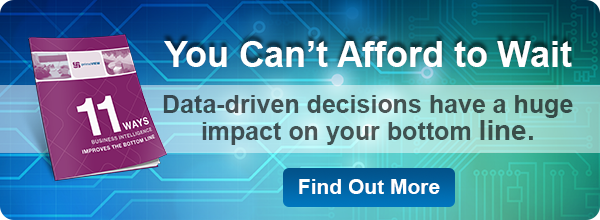 Recognizing the value of Business Intelligence to monitor and manage your business is one thing. Doing something about it is another? What is the next step? Do you build it or buy it? Admitting we are biased towards “Buy it,” we will identify what appears to be “best practice” for most SMBs.
Recognizing the value of Business Intelligence to monitor and manage your business is one thing. Doing something about it is another? What is the next step? Do you build it or buy it? Admitting we are biased towards “Buy it,” we will identify what appears to be “best practice” for most SMBs.
Build it?
While several larger provider organizations have elected to invest the time, resources, and money to build their own data warehouse and reporting systems, such an investment is far out of the financial reach and expertise for most SMBs. Here are some of the key reasons why not to build is the better decision:
Those who have their own IT departments think they can do it themselves – It’s just a matter of directing the IT manager to create reports, isn’t it? Actually, it’s not that simple. Because they think they know how, we have discovered that some well-intentioned companies will start by hiring a programmer to write reports. However, business intelligence is interactive and displays critical Key Performance Indicators (KPIs) not only as tables, but as graphs and charts as well, involving higher levels of reporting. The distinction is that BI dashboards provide greater versatility than a report generator. It uses a warehouse to aggregate data, no matter the source, and normalizes the data so that the data is interoperable – where data comes from disparate sources, yet must work together. In this way, trending information becomes easier. Business intelligence also enables the users to roll up and or drill down to critical information depending on their needs and permissions. What we have observed is that the one programmer becomes multiple programmers as the project falls further behind and the requirements expand.
Beyond the danger of scope creep and its unforeseen impact on the budget, there is the development time to consider. Programmers have to learn the various databases that serve as the data generators and repositories. This requires expertise in data warehouse technologies and best practices. Without going too deep, another complication is retrieving the data on a scheduled basis and combining it into useful information. And, in our observations, all of this can take up to eight months on average and, in some cases, years. Then there is the situation where the nature of an application’s database may change, requiring understanding and a working knowledge of the new database.
Assuming the developers have BI up and running, it doesn’t stop there. As competitive, regulatory, reimbursement, and new legislative pressures evolve, so must Business Intelligence. That means that the BI project never ends. Building and maintaining it requires retaining in-house specialists or engaging outside resources – an expensive proposition.
There are other non-development issues to consider, such as the actual go-live, the initial user training, and on-going support. Since LTC does experience high turnover even among members of the management and executive teams, training is a recurring issue and, more importantly, so is support.
Then there is the power of the aggregation of understanding what providers across the country need and want to view, what information is important to them, and how to turn their data into actionable information. That uniquely is found with those who have developed and maintained dashboards for years for providers across the country at affordable economies of scale.
Buy it
Let’s assume that if you were tempted to create your BI tool or you have started it and found it to be a big black hole that seems to suck in more time and funds that your worst fears anticipated, pause. It’s never too late to cut your losses and investigate what is already available. But, though we consider this to be the right direction, we recommend you do your homework before you buy. Beyond the usual promotional materials and even the demonstration, consider the following:
- Outsourcing BI can be less expensive in the short and long term. Investigate the monthly subscription fees and any one-off fees. Know what you are getting yourself into financially.
- Get an estimate of the time it takes to get the system up and running. In our experience, assuming we have the necessary information needed to create connections to the various data sources, we have been able to get customers fully up and running in a matter of weeks.
- How long has the vendor been developing and satisfactorily meeting the needs of its customers? Our primeVIEW has been evolving with long term care providers for years which brings up another issue. Is the BI vendor responsive to customer requests for new features in a timely manner? Responsiveness is critical to providers who must be prepared to deal with changing challenges and opportunities quickly.
Summary
We highly recommend that you seriously consider looking into procuring a BI system developed by specialists who understand LTPAC and BI technologies. It’s cost-effective, scalable, and they can offer suggestions, based on what other providers have done. LTPAC specialists, like primeVIEW, also listen to customer suggestions to further enhance business intelligence’s capabilities and anticipate providers’ information needs. Our customers acknowledge that such a strategy is affordable and highly effective in controlling costs, ensuring compliance, improving service quality, and improving cash flow without the distractions inherent in “do-it-yourself” BI development.

/Prime-Care-Technologies-Logo.png?width=191&height=55&name=Prime-Care-Technologies-Logo.png)

 Recognizing the value of Business Intelligence to monitor and manage your business is one thing. Doing something about it is another? What is the next step? Do you build it or buy it? Admitting we are biased towards “Buy it,” we will identify what appears to be “best practice” for most SMBs.
Recognizing the value of Business Intelligence to monitor and manage your business is one thing. Doing something about it is another? What is the next step? Do you build it or buy it? Admitting we are biased towards “Buy it,” we will identify what appears to be “best practice” for most SMBs.
